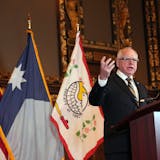A surge in people moving from elsewhere in the country to the Twin Cities last year contributed to the metro area's population growth, which added a quarter-million residents since 2010, according to the latest estimates from the U.S. Census Bureau.
The 43,000 new residents last year also marked the largest year-over-year growth for the Twin Cities in recent history, according to a demographer with the Brookings Institution. The additional residents since 2010 bring the metro area's population to just over 3.6 million, holding steady as the 16th-largest metro in the country.
The Twin Cities' growth lags that of its rival metros, such as Seattle, Portland and Denver, and it's well behind by the population boom in Florida and Texas cities. But those who analyze the data are optimistic about the impact on the local economy.
Matt Lewis tracks the movement of "working professionals" — specifically people over 23 with an associate degree or higher — to the metro area for Greater MSP. Looking at five-year averages, he recently found that 2016 was the best year for attracting new professionals to the region since tracking began in 2007.
"When we're looking at professionals in the workforce, something happened where our performance notably jumped in 2016 — and that trend looks like it's continuing," Lewis said.
The Census Bureau's definition of the Twin Cities metro extends to 16 counties surrounding the central cities, extending northward to Mille Lacs and eastward to western Wisconsin. About 85 percent of the population lives in the seven-county area.
The net number of people who moved to the Twin Cities from elsewhere in the country, versus those who left, rose dramatically last year, according to the new census data, which is derived from the American Community Survey. And 2017 was the first year since 2001 that more people moved to Minnesota from other states than moved out of state, according to census data crunched by the state demographer's office.
Demographers won't be able to explain precisely who these people are until more data becomes available. But demographer Susan Brower said it is good news for the local economy, because existing residents are dying in higher numbers and births are relatively flat.



